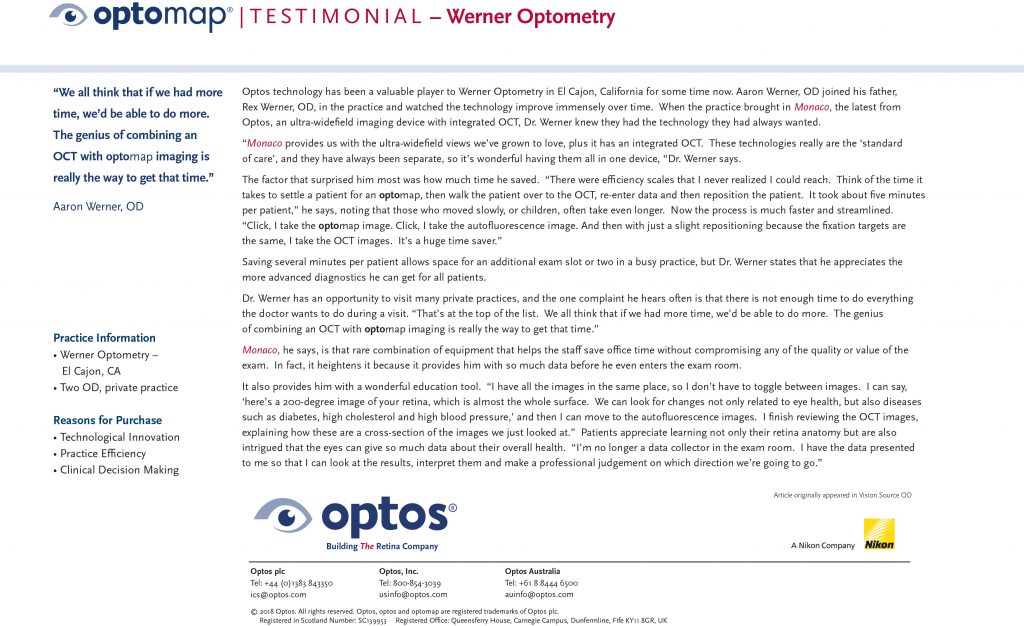In 2000, Optos delivered the first and only retinal imaging device that could capture beyond the vortex vessels of the retina. The ability to clearly image that much of the retina—in one capture, and in less than ½ second—significantly influenced the way eye care professionals examined their patients’ eyes. The core technology is based on a scanning laser ophthalmoscope and a unique ellipsoid mirror that create a virtual focal point inside the eye to enable the single capture of the central retina and periphery. For color images, green and red lasers are engaged simultaneously to allow visualization of retinal substructures from the sensory retina and retinal pigment epithelium to the choroid.
Over the years, Optos has continued to develop its hardware and software platforms – most recently delivering Monaco, the newest device providing new ways to enhance clinical exams. It is the only ultra-widefield (UWF™) retinal imaging device with integrated OCT. Monaco produces a 200° single-capture optomap image in less than ½ second and also provides cross-sectional 40° OCT views of retinal structures. Monaco enables a rapid multi-modality capture featuring color, autofluorescence and OCT scans, for both eyes, in as little as two minutes. UWF with integrated OCT saves time, space, and minimizes patient movement. optomap images and OCT scans are correlated to facilitate pathology examination. Color, AF, and OCT images are shown in a single, comprehensive view on a single device. The introduction of Monaco further differentiates Optos’ products with continued ease of use and speed of capture. OCT scans available with the device are: Line Scan, Raster Scan, Retina Topography Scan, Optic nerve Head (OnH) Topography Scan, and Retinal nerve Fiber layer (RnFl) Scan.

Optos technology has been a valuable asset to Werner Optometry in El Cajon, California for some time now. Aaron Werner, OD joined his father, Rex Werner, OD, in the practice and has watched the technology improve immensely over time. When given the opportunity to present Monaco in their practice, Dr. Werner knew this was the technology they had always wanted.
Dr. Werner was most surprised by how much time he saved in the exam room. “There were efficiency scales that I never realized I could reach. Think of the time it takes to settle a patient for an optomap, then walk the patient over to the OCT, re-enter data and then re position the patient. It took about five minutes per patient,” he says, noting those some often take longer. Dr. Werner adds that saving several minutes per patient allows space for an additional exam slot or two in a busy practice, but he himself appreciates the more advanced diagnostics he can get for all patients.
Dr. Werner, among many others, often feel there is never enough time to do everything the doctor wants to do during a visit. “That’s at the top of the list. We all think that if we had more time, we’d be able to do more. The genius of combining and OCT with optomap imaging is really the way to get that time.”
Monaco, he says, is that rare combination of equipment that helps the staff save office time without compromising any of the quality or value of the exam. In fact, it heightens it because it provides him with so much data before he even enters the exam room. Monaco has also provided Dr. Werner with an excellent education tool. “I am no longer a data collector in the exam room. I have the data presented to me so that I can look at the results, interpret them and make a professional judgement on which direction we’re going to go. “Patients appreciate learning not only their retina anatomy but are also intrigued that the eyes can give so much data about their overall health. Read Dr. Werner’s full testimonial here…
To learn more about Monaco and other ultra-widefield devices from Optos, visit our contact us to discuss offerings with your local Optos representative.